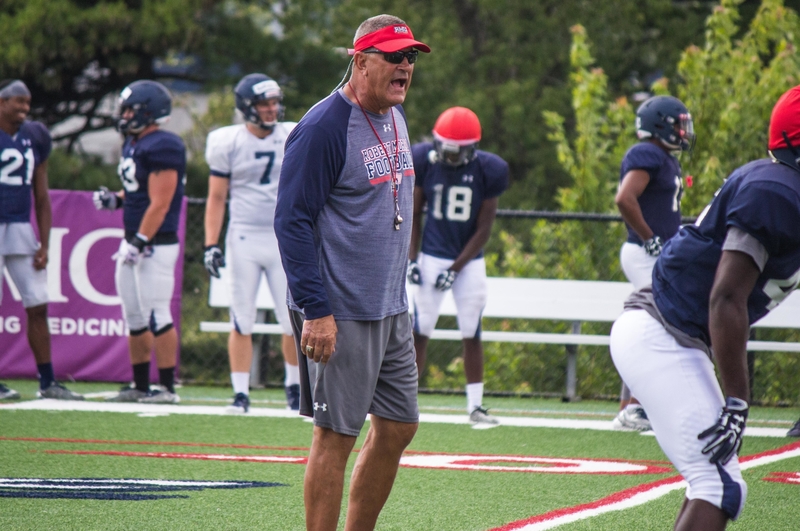Photo credit: Samuel Anthony
Recapping the John Banaszak Era
Opinion
November 20, 2017
The John Banaszak Era of Robert Morris University football has finally sputtered out to its brief and uninspiring end on Monday morning to finish a coaching stint that never really gained any momentum in its four seasons.
The face value of John Banaszak’s legacy is a career record of 9-35, one of the worst offenses in all of college football and a lot of question marks as to where this once storied program is headed after nearly a decade of inferiority.
But despite the failures in the win column, the John Banaszak Era marked many changes, both good, the bad and the ugly within the Robert Morris University football culture. So let’s take a minute to reflect on the legacy that Banaszak will leave behind within the halls of Joe Walton Stadium.
The Good
While many focus on just the bad of Banaszak’s time as head of the RMU football program, some of the changes that Banaszak made have provided much-underlying success that many have failed to notice.
Changing the uniforms
The start of the John Banaszak Era began with a change in the actual look of the Colonials on-field product.
Before John Banaszak, The Colonials jerseys were plain, the team helmets were a basic white that didn’t look good by themselves and looked even worse with the old blue uniforms the team donned.
RMU football looked like a team from the nineties playing in 2013. But, when John Banaszak came in, the jerseys were redone to today’s more modern look, the helmets became a nice matte blue, and the team was able to make themselves more marketable through their appearance as a more modern football team.
In a college football landscape was becoming more about what a team was wearing, a more modern look made Robert Morris a far more notable location for the better talent that the Colonials were trying to attract.
What many do not realize is that much of this change is thanks to John Banaszak.
Special Teams Success
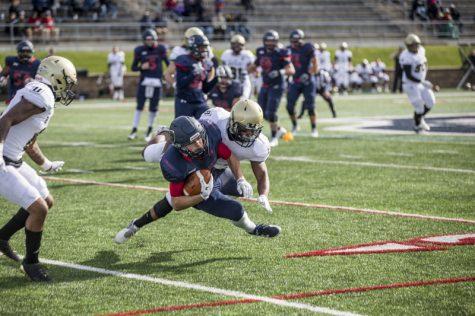
While the offense was perhaps the biggest failure for Banaszak, the team’s special teams was a source of pride for the Colonials.
Without an actual special teams coordinator, that part of the team was directly called and coached by Banaszak and was consistently one of the top special teams units in the Northeast Conference.
The team has spent the past four years within the top three in punt returns, have placed first in punt return touchdowns in two of those past four seasons and in 2016, the team placed top three in five different special teams categories within the NEC.
There was a point in 2016, where teams would not even kick off to the Colonials, choosing to squib kick the football rather than give the ball to Dante Satcher, who before his injury early in that season was one of the best kick returners in the nation.
Much of this success was directly due to John Banaszak.
Defensive Improvement
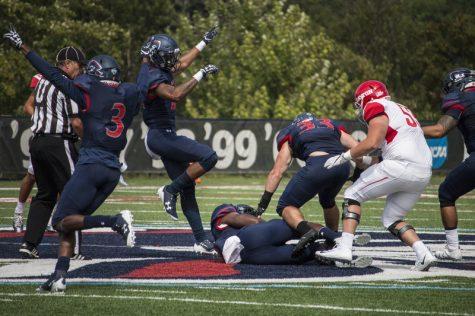
The Robert Morris Defense has continued to be dominant through the past four years. Photo credit: Katey Ladika
It’s unfair to critique the John Banaszak era without acknowledging the significant improvement his defenses saw.
The first season of Banaszak’s reign featured a defense that was last in the NEC in scoring giving up 34.3 average points per game and also last in the NEC in yards with 420.4 yards per game. To put into perspective how atrocious that defense was, the second worst NEC defense gave up about six points and 71 yards less on game average than Robert Morris. Keep in mind these were not Banaszak’s players. These players were left over from the disappointing end to the Joe Walton era. It was clear to Banaszak needed to make some changes.
And changes he made. One of them being the significant move of promoting potential Banaszak replacement Scott Farison to assistant coach and giving him more of a say in the defense. One might argue that it was Farison’s defense and he deserves all the credit. One could also say that being a leader requires the ability to know when to control and when to delegate. Giving Fairson a major role in the defense was clearly the right move to make and helped give Robert Morris at least one bright spot in the disappointing years under Banaszak.
After coach Banaszak’s first season the defense jumped from last to third in the NEC in scoring. Robert Morris gave up a per game average of 13.2 points less than the year prior to an average of 21.1 points per game. In terms of yards per game, the defense averaged almost 100 yards less than the year prior to an average of 321.4.
From then on, RMU’s defense would continue to be a bright spot for the team. Robert Morris would finish the following season with the third-ranked scoring defense in the NEC. However, partly due to some seniors graduating and an extremely difficult nonconference schedule that included North Dakota State and Youngstown State, that defense fell to 6th in the NEC in scoring. They gave up an average of 30.1 points per game. That being said, that number isn’t an entirely fair assessment of the RMU defense as they did manage to finish third in the NEC in total defense with an average of 348.8 yards per game. It is difficult to have a low scoring defense when the offense fails to routinely drive the ball down the field.
The Bad
While there was some good that John Banaszak was able to create, it was ultimately outweighed by the constant struggles of problems that seemed to haunt Banaszak with no solution to be found.
Failure to retain and develop talent
And to add to the agony of such a poor offense, it seems as though whenever Robert Morris brings in the talent which will solve its offensive woes, these players either leave or fail to truly meet expectations.
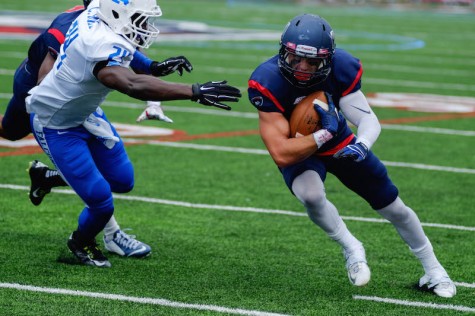
Players like former NEC Rookie of the Year Kyle Buss, who was tearing up secondaries one minute while claiming the all-time RMU record for receptions per game, and transferring to the University of Connecticut the next. Or like Rameses Owens, a player who still sits 10th on the all-time rushing list for RMU, who made the move that he was done with Colonials football after two seasons.
The Matthew Barr’s and the Jimmy Walker’s who were brought in with high expectations and the belief that this team had finally found their quarterback, only to be disappointed by inconsistencies and failure to create any scoring.
Matthew Barr came into his freshman year at Robert Morris with high expectations as a player with a great arm who can make plays on his feet if needed. What became of Barr was a slew of injuries from a 2017 season that has seen Barr come in at both wide receiver and quarterback.
Jimmy Walker was the highly touted recruit from FBS school San Diego State expected to come in ready to make an immediate impact. But with the help of a struggling offensive line, the team still finished as one of the worst passing teams in the country.
These quarterback troubles stem from the revolving door that is the Robert Morris offensive line. The team has consistently seen their opening game starting line become a combination of different freshman and sophomores whose struggles come from their lack of experience.
Lack of Leadership
This problem of development and retention comes from John Banaszak’s lack of leadership, a key staple of a successful college football coach.
If players enjoyed playing for Robert Morris and coach Banaszak, this team wouldn’t see so many transfers and players choosing to leave the team. There wouldn’t be so many players who fail to develop beyond their talents in high school.
It would also mean that the team’s struggles with discipline would not be so severe. This team has averaged almost 80 yards in penalties per game this season, which includes the team’s loss to Duquesne where they almost amounted a total of 200 yards in penalty yards.
This Robert Morris team failed at some of the most simple things, avoiding penalties being the most costly of them all.
The Ugly
Then there is the ugly, a category for the parts of Banaszak’s tenure which were exceptionally bad, marking the frustration that has followed this team the past four seasons. If you don’t like ugly things then you might want to look away, because this last category gets pretty bad.
Offensive Agony
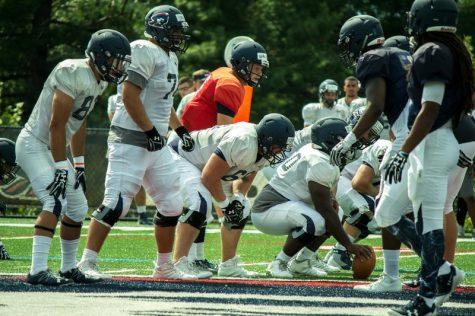
The John Banaszak Era Colonials may have produced some of the worst offensive numbers in the history of Robert Morris Football.
During John Banaszak’s tenure as head coach, the team was shut out a total of seven times in four seasons. In the 20 previous years of the program, the team was only shut out a total of four times. To put that into perspective, before John Banaszak, the team averaged getting shut out once every five years, with Banaszak, the team was shut out almost twice a season.
On top of that, the total offense has been one of the worst in the nation for Banaszak’s entire tenure with almost no improvement at all.
In each of Banaszak’s four seasons, the team has placed as one of the worst 10 offenses in the entire nation, finishing as the worst offense in the entire country in 2016.
The highest the team has placed in rushing offense was 92nd out of 122 teams. The best finish for the passing offense was this season when the team ranked as the 97th best passing offense in the country.
This offense has been held scoreless by Division II teams and been given trouble by some of the worst defenses in the nation which speaks to the team’s inferiority on that side of the ball.
Final Thoughts
These are the legacies that John Banaszak will leave for Robert Morris football. In a coaching era where the bad outweighed the good, what is left is simply where will this team go next? How long is the road back to success? And what course will this team take in the selection of their next head coach?
All of these questions will be answered in the coming months. These answers will affect the history of the team for years to come. So for the sake of this team, the choice better be a good one.
